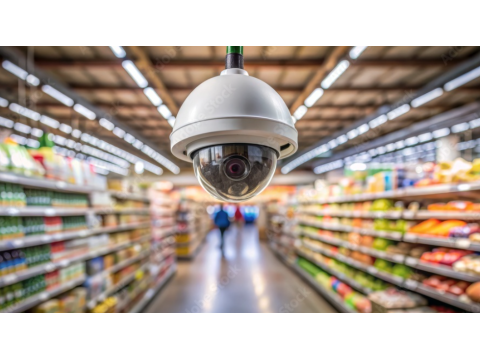Video Surveillance in Supermarkets
Effective video surveillance systems are essential for monitoring large-scale retail operations, ensuring safety, and preventing theft. Properly installed systems enable real-time monitoring and post-event analysis, covering areas like sales floors, cash registers, storage rooms, and loading docks.
Key Components and Benefits of Surveillance
1. Enhanced Security
- Surveillance cameras deter theft by monitoring customer behavior and employee activities.
- Integrated systems like Cash Control help reduce incidents of fraud and ensure accurate transaction monitoring.
2. Operational Efficiency
- Surveillance assists in managing customer flow, ensuring efficient use of space and optimized staff allocation.
- Video records support training efforts by highlighting best practices and identifying areas for improvement.
Classification of Supermarket Surveillance Systems
Standard Systems
- Feature SD-resolution cameras with basic functionality, suitable for small retail setups.
- Allow remote viewing but lack advanced analytics.
Professional Systems
- Utilize HD cameras for high-quality video feeds, ideal for large supermarkets.
- Support advanced analytics, remote management, and integration with other systems like cash register monitoring.
Core Features of Supermarket Surveillance
1. Cash Control Monitoring
- Cash Control systems consist of hardware and software that monitor cashier activities in real-time.
- These systems ensure compliance, detect anomalies, and reduce theft by continuously logging transactions and correlating them with recorded video.
2. Multi-Zone Monitoring
Surveillance systems must cover:
- Parking areas: Prevent vehicle-related crimes.
- Entrance zones: Capture foot traffic and potential threats.
- Cashier zones: Monitor transactions for irregularities.
- Sales floors: Track customer movement to optimize displays and prevent theft.
- Storage and loading docks: Prevent inventory loss and ensure safety compliance.
3. Legal Compliance
- Ensure systems adhere to local privacy laws and regulations, with clear signage informing customers of active surveillance.
Criteria for Choosing Surveillance Systems
1. Camera Placement
- Cameras should be installed at strategic locations with minimal blind spots.
- Use wide-angle lenses for general monitoring and zoom lenses for specific tasks like cashier monitoring.
2. Real-Time vs. Archived Monitoring
- Decide on the balance between live monitoring for security purposes and archived footage for post-event analysis.
3. Technology Integration
- Systems should integrate seamlessly with existing security infrastructure, such as alarms and access control.
- Advanced systems support analytics like heat mapping to identify high-traffic areas.
Advanced Features of Professional Systems
1. High-Resolution Imaging
- HD and 4K cameras capture clear footage, essential for identifying individuals and small objects.
2. Night Vision and Low-Light Performance
- Infrared (IR) technology ensures visibility in poorly lit areas, such as storage rooms and parking lots.
3. Remote Access and Cloud Storage
- Allow managers to access live feeds and recorded footage via mobile apps or web platforms.
- Cloud storage ensures secure and scalable data archiving.
4. Customizable Alerts
- Systems can notify security teams of unauthorized access or unusual activity via email or mobile alerts.
Implementation Best Practices
Strategic Planning:
- Identify high-risk areas and prioritize camera installation accordingly.
Regular Maintenance:
- Schedule periodic checks to clean camera lenses, update firmware, and ensure uninterrupted recording.
Training:
- Train security staff on effectively using the system, reviewing footage, and responding to incidents.
Customer Transparency:
- Display signs indicating active surveillance to comply with legal requirements and build trust.
Conclusion
- Enhanced Security and Accountability: Advanced surveillance reduces theft and improves transparency in cash handling.
- Operational Insights: Analyze customer behavior to refine store layouts and boost sales.
- Compliance and Reliability: Ensure adherence to legal standards and maintain system reliability with regular updates.
- Future-Ready: Choose scalable systems that can integrate with emerging technologies like AI analytics and facial recognition.
Investing in a robust video surveillance system ensures security, efficiency, and customer satisfaction, making it indispensable for modern supermarkets.
Bank Surveillance Systems
10/01/2025
Office Surveillance Systems
10/01/2025

